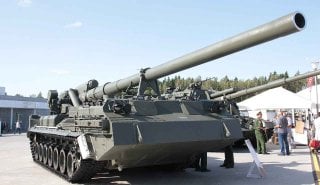One Shot, One Kill: Meet Russia's 2S7M Malka Artillery Gun
The Malka should be seen as a serious weapon, albeit with some caveats.
Authors Charles W. Sasser and Craig Roberts likely didn't come up with the unofficial military term "One Shot—One Kill," yet they popularized it with their 1990 book of that name about American combat snipers from the Second World War through Vietnam and beyond. The idea of scoring a "kill" with a single shot at extremely long range has comparisons to golf's "hole in one."
For trained snipers with the right equipment, however, the one shot, one kill is likely easier to accomplish.
The Russian military has certainly seen its fair share of snipers able to make kills at extreme distances, but on Friday, the Kremlin touted how it has a weapon that could take out an enemy tank and defensive structures at such distances with a single round.
Meet the 2S7M Malka
In July 2020, the Russian state-owned military-industrial conglomerate Rostec began deliveries of its upgraded 2S7M Malka, an upgraded to the 2S7 Pion, the heavy self-propelled artillery system that was developed in the 1980s to fire a small tactical nuclear payload at NATO forces.
The 203mm Malka—described as being among the most powerful self-propelled guns—was designed to strike vital enemy targets and facilities in the tactical depth behind the front lines. When it was introduced, Rostec suggested it could destroy a building with a single shot. This week, the company's boasts have gone even further.
"A tremendous impact and the detonation of nearly 20 kg of explosives create a powerful destruction effect. It is capable of wiping out even concrete-made fortifications, structures, bridges, river crossings and other installations. Heavy munitions leave craters of up to seven meters in the ground and tear armor to pieces. Each projectile scatters a mass of fragments over a considerable radius," Rostec said via a statement to Tass.
Being Used in Ukraine
The report from Tass indicated that the 2S7M Malka is now being employed alongside the 2S7 Pion in Russia's ongoing "special military operation" in Ukraine, including "in the Avdeyevka frontline area in the Donbas region," where it has the capability to make "buildings fold down."
That is obviously hyperbole, and we can't dismiss the destructive power of a 203mm round—notably the 3G3 Galyan projectile, a "Concrete piercing shell… designed to strike hardened targets, such as command bunkers" (source: Weaponsystems.net). The Malka should be seen as a serious weapon, albeit with some caveats.
First, it is the successor to a platform that never was employed by the Soviet military in an armed conflict. The only known use of the 2S7 Pion self-propelled artillery gun was in the war in South Ossetia when Georgian military units used a battery of six of the weapons against Russian forces with limited success. All were hidden when the Georgian forces retreated, and one of those was captured by Russian troops and taken as "war booty," while the others were destroyed.
Thus the upgrades and enhancements weren't based on the Kremlin's battlefield experience.
Moreover, while the 2S7M is reported to have a rate of fire of up to 2.5 rounds per minute to a range of approximately 50 km (31 miles), its accuracy remains questionable. Scoring a direct hit in one shot seems unlikely, and would be more akin to a golfer's hole-in-one than a sniper's long-range kill. In other words, it would be a matter of luck as much as true skill.
A Kremlin video that was released during the summer of 2022 suggested that the Malka had successfully destroyed a Ukrainian-operated M777 self-propelled gun, but whether it was accomplished with one shot remains questionable. More likely, it was just a lucky shot in an ensuing artillery duel.
Author Experience and Expertise: Peter Suciu
Peter Suciu is a Michigan-based writer. He has contributed to more than four dozen magazines, newspapers, and websites with over 3,200 published pieces over a twenty-year career in journalism. He regularly writes about military hardware, firearms history, cybersecurity, politics, and international affairs. Peter is also a Contributing Writer for Forbes and Clearance Jobs. You can follow him on Twitter: @PeterSuciu. You can email the author: [email protected].
Image: Wikimedia Commons.

